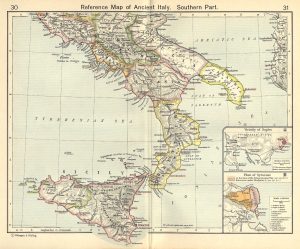Italy has been a center of art, culture, and history since the dawn of civilization. The country’s rich history can be traced back to the ancient world, with countless stories of great empires, battles, and achievements that have shaped the world we know today. One of the most fascinating ways to explore Italy’s history is through its ancient map, which tells the story of the peninsula and the people who once inhabited it. In this article, we will delve into the intriguing world of the map of ancient Italy, revealing its wonders, secrets, and trivia.
The map of ancient Italy is a fascinating piece of art that portrays the geographical and political landscape of the Italian peninsula during the Roman Republic and Empire. The map is a mosaic, made up of hundreds of small pieces of colored stones and glass called tesserae, which were cut and arranged by skilled craftsmen to create intricate and detailed images. The map was created around the 4th century AD, and it is believed to have been commissioned by an aristocratic Roman family.
One of the most striking features of the map is its intricate design, which showcases the cities, towns, rivers, mountains, and other geographical features of the Italian peninsula. The map is divided into several sections, each representing a different region of Italy, such as Tuscany, Latium, Campania, and Apulia. Each section is adorned with colorful images of the cities and towns, showing their layout, buildings, temples, and other important structures.
One of the most impressive aspects of the map is its accuracy, considering the limited technology and knowledge available at the time. The map accurately depicts the road network, the distances between cities, and the physical features of the landscape, such as rivers, mountains, and forests. This level of precision was essential for the Roman Empire, which relied heavily on the transportation of goods and troops across the country.
Aside from its accuracy, the map of ancient Italy also offers a glimpse into the lives of the people who once lived in the region. The map showcases the numerous temples, amphitheaters, and other structures that were important to the ancient Romans, as well as the aqueducts and other engineering feats that allowed them to control the flow of water and other resources. By studying the map, we can gain a better understanding of how the ancient Romans lived, worked, and interacted with their environment.
But the map of ancient Italy is not just a historical artifact. It also holds numerous secrets and trivia that make it all the more fascinating. For instance, did you know that the map is not entirely accurate, and some of the cities and towns depicted on it were never actually built? This is because the map was created based on written records and hearsay, rather than firsthand observations. Some of the cities were also exaggerated in size or importance to appease the egos of the aristocratic families that commissioned the map.
Another interesting trivia about the map is that it contains several hidden messages and symbols that were meant to convey secret or esoteric meanings. For instance, some of the towns on the map are shaped like animals or mythical creatures, such as a wolf, a serpent, and a centaur. These shapes were meant to convey symbolic meanings, such as strength, wisdom, and bravery. The map also contains numerous hidden inscriptions and codes that have yet to be fully deciphered by scholars.
In conclusion, the map of ancient Italy is a fascinating piece of art and history that offers a window into the ancient world. Its accuracy, precision, and intricate design make it a masterpiece of ancient cartography, while its secrets and trivia make it all the more intriguing. By studying the map, we can gain a better understanding of how the ancient Romans viewed their world and how they interacted with it. It provides us with a glimpse into their beliefs, values, and way of life, as well as the incredible engineering and architectural feats that they achieved.
Moreover, the map of ancient Italy also serves as a reminder of the long and rich history of the Italian peninsula. It shows us the many civilizations and empires that have inhabited the region, from the Etruscans and the Greeks to the Romans and the Byzantines. It reminds us that Italy has been a center of art, culture, and history for thousands of years, and that its influence has reached far beyond its borders.
In conclusion, the map of ancient Italy is a treasure trove of history, art, and culture that has captivated scholars and enthusiasts for centuries. Its intricate design, accuracy, and hidden meanings make it a masterpiece of ancient cartography, while its wealth of information provides us with a glimpse into the lives of the ancient Romans. By exploring this fascinating map, we can gain a deeper appreciation of the rich history and culture of Italy, and the important role it has played in shaping the world we know today.

